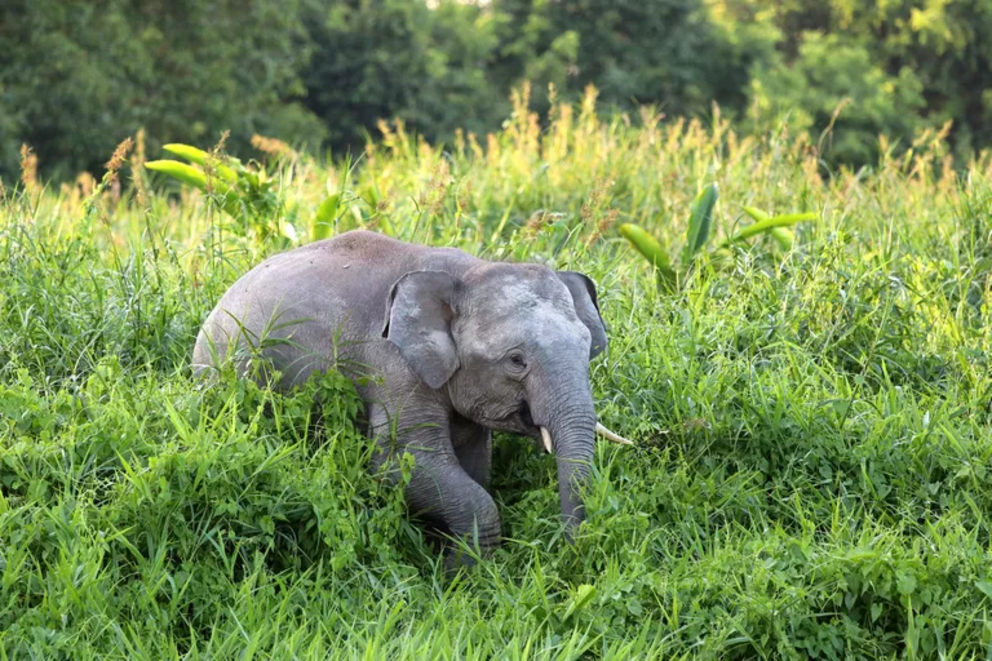What's being done to help save endangered Bornean elephants?
The world's smallest elephant is facing challenges from habitat loss, human conflict, and poaching.
Like Asian elephants in general, Bornean elephants have been considered endangered with a decreasing global population since 1986, though they were believed to be “very rare” by the International Union for Conservation of Nature as early as 1965. Today, there are estimated to be less than 1,500 individuals left on Earth.
The smallest of the Asian elephant subspecies, Bornean elephants (sometimes referred to as pygmy elephants) average anywhere from 8.2 to 9.8 feet tall. They typically also have longer tails, larger ears, and straighter tusks than their mainland cousins. Still, these majestic animals typically represent the largest mammals in their native habitats, which range from the lowland forests of Lower Kinabatangan in the state of Sabah in Malaysian Borneo to the Indonesian state of East Kalimantan.
As to how exactly this elephant subspecies came to exist on their island homes has remained somewhat of a mystery to scientists, with some studies suggesting that they’ve lived in Borneo since the end of the Pleistocene period—about 11,000 to 18,000 years ago—when the island was part of a larger landscape.
Whichever way they arrived, one thing is clear: Bornean elephants are facing a variety of threats that may be leading to their extinction. Thanks to conservation efforts, however, we just may be able to save these deeply unique mammals from an uncertain future.
Threats

Bornean elephant conservation faces similar challenges to Asian elephants, such as habitat loss, human-elephant conflict, and poaching. Factors like deforestation influenced by an increase in global demand for palm oil have created more conflicts between humans and elephants as animals are forced to venture further into developed areas.
Habitat Loss
Habitat loss is the primary threat to Bornean elephants. Large mammals like elephants require large areas to forage, and losing entire blocks of forests to fragmentation and conversion to commercial plantations or logging can reduce contact between subpopulations.
According to the World Wildlife Fund, Sabah has lost 60% of its elephant habitat to cultivation over the last 40 years.
Human Conflict
Shrinking forests have elevated the frequency of contact with people and levels of human-elephant conflicts in Borneo.
Elephants are more likely to raid plantations in search of food or travel through developed areas. This sometimes leads to locals retaliating against the animals when they destroy their crops or threaten human settlements.
Poaching
Complete conversion of forests has also led to an increased level of poaching among Bornean elephants, which studies show have increased over the years. Between 2010 and 2017, a total of 111 elephant deaths were reported in Borneo due to poaching, compared to at least 25 during 2018 alone.
What We Can Do

Given their limited natural range and elusive nature, the plight of the Bornean elephant went relatively unnoticed for many years. Starting in the early 2000s, however, conservation groups began making their way to Borneo to manage projects like satellite tracking to better understand the subspecies’ movements and use of their forest homes.
A program led by veterinarian Cheryl Cheah, the Elephant Conservation Unit at WWF-Malaysia, and the Sabah State Forestry Department successfully attached satellite collars to at least 25 elephants from different herds between 2013 and 2020. Based on this research, local organizations can make recommendations to properly manage elephant forests, identify wildlife corridors, and maintain the most critical forest habitat areas.
Likewise, even if elephants aren’t the target for poachers, it’s not uncommon for them to become caught in snares or pitfall traps placed in forest reserves bordering plantations intended for wild boars and deer. If the elephants aren’t treated early enough, snare wounds can lead to severe infection and cause a slow and painful death.
One way to combat this threat is by conducting anti-snaring operations in elephant habitats, which is exactly what WWF-Malaysia did in 2018 after more than 25 elephant deaths were reported in just the first half of the year—several of them due to severe snare wounds. The organization searched for and removed illegal hunting platforms, snares, and pitfall traps in forests near plantations, working alongside the local government to identify poaching hot spots.
As important as conservation science studies are, the long-term survival of the Bornean elephant will rely heavily on sustainable forest management and ensuring that these animals have access to reforested wildlife corridors in order to move freely and avoid exposure to humans.
What You Can Do to Help the Bornean Elephant
- Donate to organizations like the Malaysia chapter of the World Wildlife Fund to support conservation efforts in Borneo.
- Avoid buying new wood and paper products that may have come from sustainably managed forests. Look for the Forest Stewardship Council stamp on these types of products to ensure high sustainability standards.
- Don’t purchase products containing ivory, even antique pieces that may predate strict bans on ivory.

